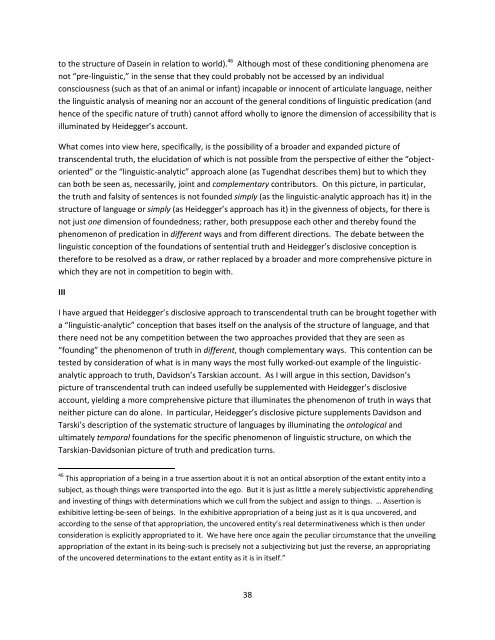Heidegger, Tugendhat, Davidson - University of New Mexico
Heidegger, Tugendhat, Davidson - University of New Mexico
Heidegger, Tugendhat, Davidson - University of New Mexico
You also want an ePaper? Increase the reach of your titles
YUMPU automatically turns print PDFs into web optimized ePapers that Google loves.
to the structure <strong>of</strong> Dasein in relation to world). 46 Although most <strong>of</strong> these conditioning phenomena are<br />
not “pre-linguistic,” in the sense that they could probably not be accessed by an individual<br />
consciousness (such as that <strong>of</strong> an animal or infant) incapable or innocent <strong>of</strong> articulate language, neither<br />
the linguistic analysis <strong>of</strong> meaning nor an account <strong>of</strong> the general conditions <strong>of</strong> linguistic predication (and<br />
hence <strong>of</strong> the specific nature <strong>of</strong> truth) cannot afford wholly to ignore the dimension <strong>of</strong> accessibility that is<br />
illuminated by <strong>Heidegger</strong>’s account.<br />
What comes into view here, specifically, is the possibility <strong>of</strong> a broader and expanded picture <strong>of</strong><br />
transcendental truth, the elucidation <strong>of</strong> which is not possible from the perspective <strong>of</strong> either the “objectoriented”<br />
or the “linguistic-analytic” approach alone (as <strong>Tugendhat</strong> describes them) but to which they<br />
can both be seen as, necessarily, joint and complementary contributors. On this picture, in particular,<br />
the truth and falsity <strong>of</strong> sentences is not founded simply (as the linguistic-analytic approach has it) in the<br />
structure <strong>of</strong> language or simply (as <strong>Heidegger</strong>’s approach has it) in the givenness <strong>of</strong> objects, for there is<br />
not just one dimension <strong>of</strong> foundedness; rather, both presuppose each other and thereby found the<br />
phenomenon <strong>of</strong> predication in different ways and from different directions. The debate between the<br />
linguistic conception <strong>of</strong> the foundations <strong>of</strong> sentential truth and <strong>Heidegger</strong>’s disclosive conception is<br />
therefore to be resolved as a draw, or rather replaced by a broader and more comprehensive picture in<br />
which they are not in competition to begin with.<br />
III<br />
I have argued that <strong>Heidegger</strong>’s disclosive approach to transcendental truth can be brought together with<br />
a “linguistic-analytic” conception that bases itself on the analysis <strong>of</strong> the structure <strong>of</strong> language, and that<br />
there need not be any competition between the two approaches provided that they are seen as<br />
“founding” the phenomenon <strong>of</strong> truth in different, though complementary ways. This contention can be<br />
tested by consideration <strong>of</strong> what is in many ways the most fully worked-out example <strong>of</strong> the linguisticanalytic<br />
approach to truth, <strong>Davidson</strong>’s Tarskian account. As I will argue in this section, <strong>Davidson</strong>’s<br />
picture <strong>of</strong> transcendental truth can indeed usefully be supplemented with <strong>Heidegger</strong>’s disclosive<br />
account, yielding a more comprehensive picture that illuminates the phenomenon <strong>of</strong> truth in ways that<br />
neither picture can do alone. In particular, <strong>Heidegger</strong>’s disclosive picture supplements <strong>Davidson</strong> and<br />
Tarski’s description <strong>of</strong> the systematic structure <strong>of</strong> languages by illuminating the ontological and<br />
ultimately temporal foundations for the specific phenomenon <strong>of</strong> linguistic structure, on which the<br />
Tarskian-<strong>Davidson</strong>ian picture <strong>of</strong> truth and predication turns.<br />
46 This appropriation <strong>of</strong> a being in a true assertion about it is not an ontical absorption <strong>of</strong> the extant entity into a<br />
subject, as though things were transported into the ego. But it is just as little a merely subjectivistic apprehending<br />
and investing <strong>of</strong> things with determinations which we cull from the subject and assign to things. … Assertion is<br />
exhibitive letting-be-seen <strong>of</strong> beings. In the exhibitive appropriation <strong>of</strong> a being just as it is qua uncovered, and<br />
according to the sense <strong>of</strong> that appropriation, the uncovered entity’s real determinativeness which is then under<br />
consideration is explicitly appropriated to it. We have here once again the peculiar circumstance that the unveiling<br />
appropriation <strong>of</strong> the extant in its being-such is precisely not a subjectivizing but just the reverse, an appropriating<br />
<strong>of</strong> the uncovered determinations to the extant entity as it is in itself.”<br />
38
















